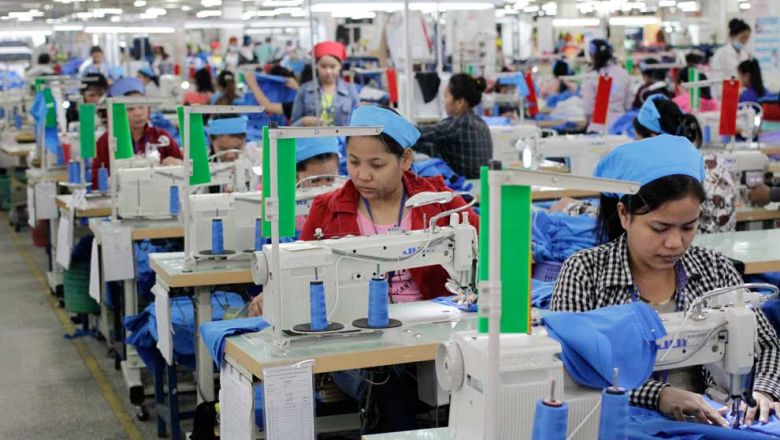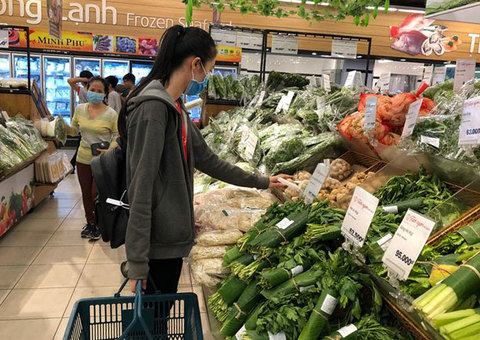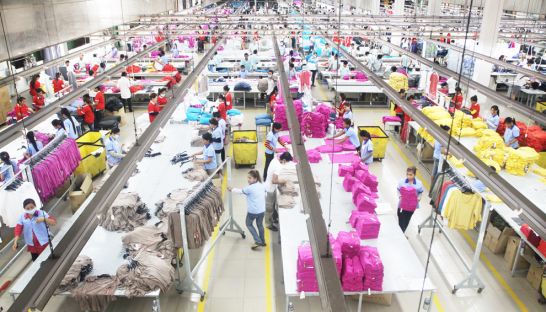Made here, owned there
Made here, owned there
At the end of a well-paved road just past the city’s airport sits a cluster of factories. Each one is barely discernible from the next – grey concrete walls and blue aluminium roofs.
But one factory in the lot, MAG (Cambodia), is different. In a country saturated with foreign investment, it’s 100 per cent locally owned.
MAG’s general manager, Nhim Bunrith, who has 17 years of experience in the sector, including in foreign-owned factories, explains the practical benefits of the arrangement.
“If we are working with a Cambodian owner, we are speaking the same language,” Bunrith said, talking from a meeting room next to the production floor, where 720 workers stitch accessories to jackets destined for Japan.
“Sometimes, managers say words with a positive meaning, but through the translator, sometimes it makes the workers understand it in a negative meaning, and then it makes them angry, and the strikes sometimes happen from that.”
Helped by EU and US trade preferences, Cambodia’s garment industry has grown from about one per cent of GDP in the early 1990s to close to 10 per cent of GDP today. Despite this boom, which has provided hundreds of thousands of steady jobs, Cambodian ownership has never taken off.
Coinciding with favourable foreign investment conditions, local ownership percentages have remained flat, much to the detriment of an industry that wants to reinvest its profits domestically.
In 2003, just 7.1 per cent of factories were owned by Cambodians, according to figures from the Garment Manufacturers Association in Cambodia (GMAC).
Now, a decade on, little has changed. Fifty-two of GMAC’s 609 members make up 8.5 per cent of the country’s garment factory ownership. The figure, according to GMAC, is probably even lower, as many are joint partnerships.
The cultural sensitivities cannot be stressed enough; in 2012, a strike ensued at a factory after the Chinese manager, who was later deported, destroyed a photo of the late King Father Norodom Sihanouk just after his death. But economic costs are there too.
Foreign ownership (largely Chinese and Taiwanese) aids industry know-how and provides employment to the majority of the 600,000 garment workers in Cambodia. However, industry observers say the overwhelming presence of foreign factories is limiting in ways that the obvious benefits conceal.
In Cambodia’s garment industry, foreign-owned ventures are often run by parent companies that operate at different stages of production outside of Cambodia.
There is very little incentive, then, to pour money into the sector here and create a more advanced domestic supply chain. As a consequence, according to the Asian Development Bank, there isn’t much room for local initiative or entrepreneurship.
“In general, it would be true to say that these offshore owners may not have a strong commitment to Cambodia and do not make significant efforts to create linkages or subcontracting networks with Cambodian companies,” said Peter Brimble, senior country economist at the Asian Development Bank.
“The critical challenge is to find ways to work with the 90 per cent or so of the industry owned by offshore investors and try to leverage their present involvement into maintaining their activities in Cambodia, expanding investments to strengthen the supply chain and stimulating Cambodian investors to enter the industry.”
But start-ups need cash, and they struggle to compete with foreign-owned companies that have access to capital at lower interest rates, making it easier to raise funds, according to Ken Loo, secretary general of GMAC.
Loo also acknowledged the commitment factor, which has its consequences.
At its most extreme, the problem has manifested itself in factory owners taking advantage of weak regulatory environments and simply packing their bags and leaving.
The most prominent case occurred in December of 2012, when the Chinese-owned Kingsland garment factory shut up shop after owners fled the country, owing thousands in lost wages and leaving hundreds jobless.
In the same month, Yung Wah closed its doors and a similar narrative unfolded. The government and buyers have had to step in and cover costs.
Minister of Commerce Sun Chanthol said that local investors are less likely to “cut and run from Cambodia”, though he couched his argument by saying that he puts great value on the knowledge and technology that foreign investors bring to the country.
“The CDC [Council for the Development of Cambodia] helps do the matchmaking between the local investors and foreign investors so that the local investors can form a joint venture with foreign investors or cooperate with them to learn the manufacturing process, which will allow them to invest more in the manufacturing sector,” he said.
Some foreign firms, however, have indicated they are in it for the long haul. Cambodia’s Stock Exchange has had only one listed company since its inception, but this year, a Taiwanese-owned garment factory is planning on an initial public offering. The Phnom Penh Special Economic Zone is backed by Japanese investors, and is expanding.
But for Bunrith, the manager at MAG (Cambodia), local ownership equates to a long-term personal investment that goes beyond money and job creation.
“Because most of the investors are foreigners, they are not really interested to make these people good, to make this country excellent,” he said, gesturing towards the workers on the floor. “Because one day when the time comes, when they don’t make a profit here anymore, they will pack their luggage and go away to somewhere else.”
phnompenh post
















